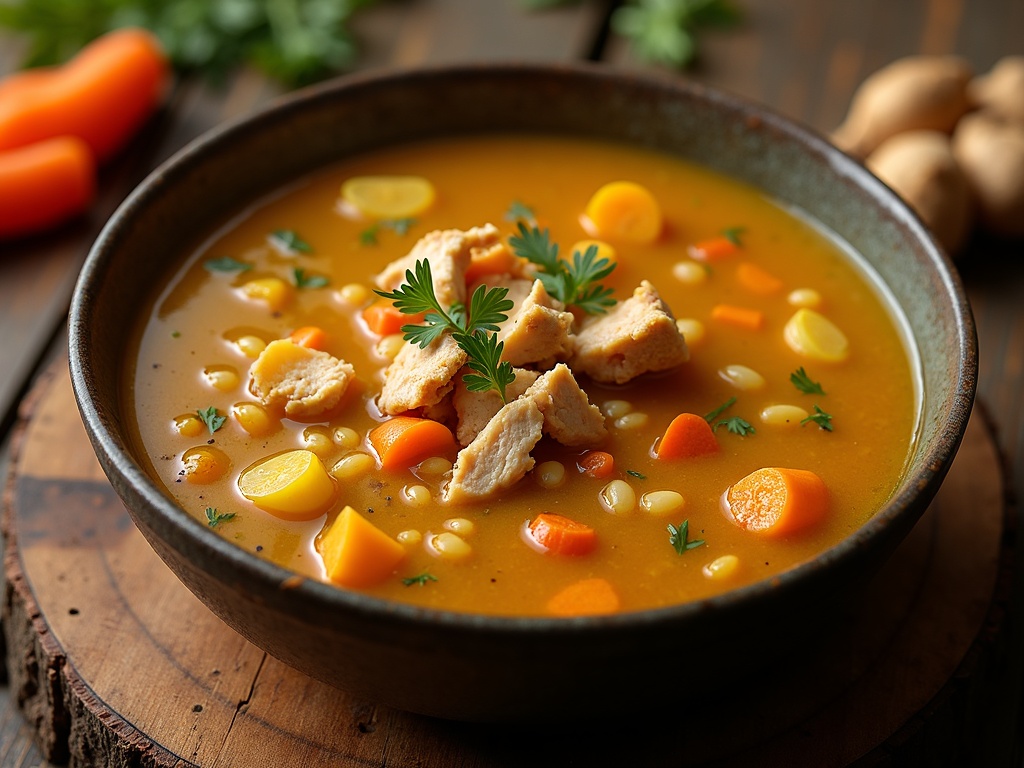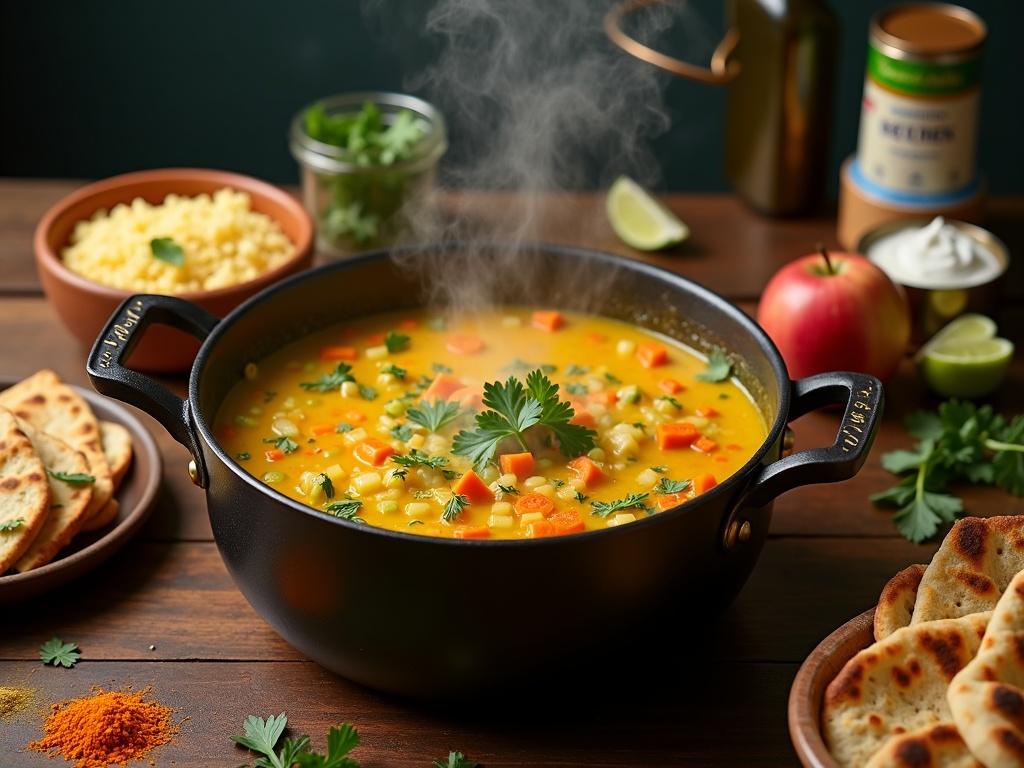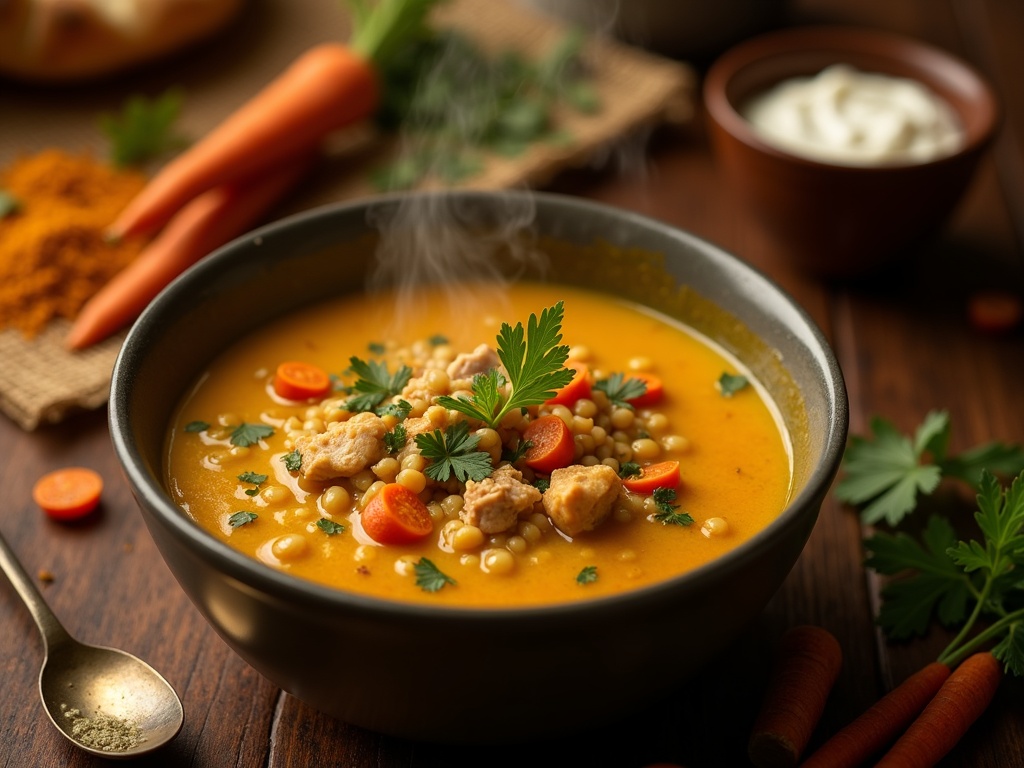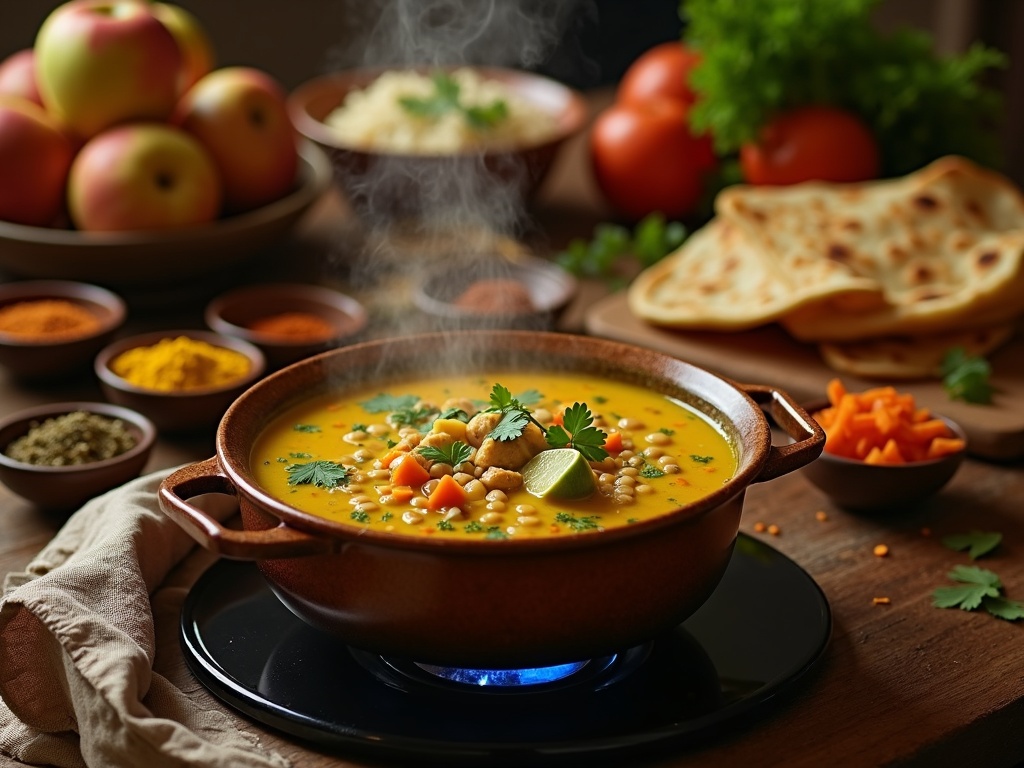Mulligatawny soup stands as a compelling culinary fusion rooted in South Indian cuisine, its name derived from Tamil words meaning “pepper-water.” This Anglo-Indian creation evolved from a simple spiced broth during British colonial times into a hearty soup that blends meat, vegetables, apples, and cream, satisfying European palates while retaining its exotic character.
Key Takeaways
- The original Tamil preparation was a thin, spicy broth with medicinal properties that British colonials transformed by adding meat, vegetables, lentils, and cream.
- Traditional recipes center around red or yellow lentils with aromatic spices like cumin, coriander, and turmeric, which give the soup its characteristic golden color.
- Regional variations include South Indian versions with coconut milk, British adaptations with diced apple, and Northern Indian varieties with warming spices like garam masala.
- A typical serving contains approximately 210 calories with 10g of protein and 8g of carbohydrates, making it suitable for various dietary needs.
- Beyond its culinary significance, mulligatawny has entered literature and media as a symbol of colonial experiences and cultural fusion, reflecting centuries of Indo-British exchange.
Origins of Mulligatawny
Mulligatawny soup has fascinating roots that trace back to South Indian cuisine. The name itself tells a story, derived from the Tamil words ‘millagu’ (pepper) and ‘tannir’ (water), literally translating to “pepper-water.” This simple spiced broth formed the foundation of what would later evolve into the hearty soup we know today.
From Tamil Roots to British Tables
I can trace mulligatawny’s journey to the British colonial period in India during the 18th century. British officials stationed in India developed a taste for local flavors but often adapted them to suit their palates. When they encountered the spicy Tamil pepper-water broth, they saw potential for something that could satisfy their desire for soup courses in formal dining.
The original Tamil preparation was quite basic – a thin, spicy broth sometimes consumed for its medicinal properties. However, the British transformed this simple concoction by adding:
- Meat (typically chicken or lamb)
- Vegetables like carrots and celery
- Apples for sweetness
- Cream or coconut milk for richness
- Lentils for body and substance
These adaptations turned a simple pepper broth into a substantial meal that could satisfy European appetites while maintaining its exotic appeal. You can find a similar transformation in other creamy Indian dishes like korma that were adapted to British tastes.
Cultural Significance and Global Spread
Mulligatawny stands as a perfect example of Indo-British fusion cuisine, representing the cultural exchange that occurred during Britain’s colonial presence in India. Unlike dishes that were simply imported without modification, mulligatawny evolved through genuine cultural blending.
The soup gained tremendous popularity in the United Kingdom, where it became a staple in many households and restaurants. The British brought it to other parts of their empire, including Australia, where it remains popular today. Modern versions can range from light and brothy to rich and hearty, similar to how butter chicken recipes vary across regions.
In contemporary cuisine, mulligatawny appears on menus in Indian restaurants worldwide, though often in forms that would be unrecognizable to those who enjoyed the original Tamil pepper-water. Some chefs create vegetarian versions using vegetable curry ingredients, while others stay true to meat-based recipes that evolved during colonial times.
The soup’s journey from simple spiced broth to beloved international comfort food reflects the complex cultural exchanges that occurred throughout history, making it much more than just a delicious meal.
The Perfect Bowl: Essential Ingredients and Popular Variations
Mulligatawny soup stands as one of the most famous Anglo-Indian culinary creations, with a rich history dating back to British colonial times. I’ve found that creating an authentic mulligatawny requires understanding both its traditional foundations and the many ways it has evolved across different regions and preferences.
Foundation Ingredients
The soul of any good mulligatawny starts with its aromatic base. Traditional recipes center around red or yellow lentils that provide both substance and protein. The signature flavor profile comes from a careful blend of spices including cumin, coriander, and turmeric, which give the soup its characteristic golden hue and warm depth.
Most authentic versions include a mix of vegetables that add texture and nutritional value. Carrots offer sweetness and vibrant color, while potatoes provide heartiness and help thicken the consistency. I often add onions, garlic, and ginger as aromatic foundations that enhance the spice profile.
For protein, several options work beautifully in this versatile soup:
- Chicken remains the most popular choice, particularly bone-in pieces that infuse the broth with flavor (try this approach in a slow cooker chicken curry for similar depth)
- Lamb creates a richer, more robust version popular in some regions
- Vegetarian adaptations rely solely on lentils and sometimes add chickpeas or tofu
- Egg can be added just before serving, similar to how it’s used in an egg curry recipe
Regional Variations
What makes mulligatawny fascinating is how it changes character across different regions and cultural adaptations. The South Indian versions often incorporate coconut milk, creating a creamier texture similar to what you might find in a chicken korma recipe but in soup form. This addition balances the spices with subtle sweetness.
Some British adaptations include diced apple for a hint of sweetness and acidity that cuts through the richness—a surprisingly effective addition. Meanwhile, Northern Indian varieties might incorporate more warming spices like garam masala and cloves, creating a profile closer to a butter chicken recipe but in soup format.
The Anglo-Indian version, perhaps the most recognized internationally, typically features chicken, apples, and cream, with a moderate spice level designed to appeal to British palates. In contrast, authentic South Indian versions pack significantly more heat from fresh green chilies and black pepper.
Modern vegan adaptations replace animal proteins with additional vegetables like bell peppers and zucchini while using coconut milk instead of cream. These variations often draw inspiration from vegetable curry recipes but in a soupier consistency.
Heat levels vary dramatically across different interpretations. Traditional South Indian versions don’t hold back on chili heat, while British adaptations tend to be much milder. I’ve found that adjusting the spice level with fresh chili rather than dried gives better control over the final result.
For meat lovers, the principles that make a great beef curry recipe also apply to mulligatawny—long, slow cooking extracts maximum flavor from the protein and allows the spices to fully develop and meld together.

Make It Your Way: Preparation Tips and Serving Ideas
Creating a perfect bowl of mulligatawny soup takes less time than you might think. This hearty Anglo-Indian soup comes together in just 30-45 minutes, making it perfect for weeknight dinners when I’m craving something warming yet sophisticated.
Step-by-Step Preparation
I start by sautéing aromatic vegetables like onions, carrots, and celery in ghee until they’re soft and fragrant. Next, I add curry powder, turmeric, and garam masala, stirring constantly to toast the spices and release their essential oils. This crucial step takes just 30 seconds but elevates the entire dish.
After adding my protein of choice (traditionally chicken, but lentils work beautifully for a vegetarian version), I pour in chicken or vegetable stock and add diced apples for that signature sweet-savory balance. A touch of coconut milk goes in during the final 10 minutes of cooking, creating the silky texture that makes this curry-based soup so delightful.
Don’t forget to taste and adjust the seasoning before serving. The complex flavor profile often needs a final touch of salt or a squeeze of lime juice to bring everything into harmony.
Serving Suggestions & Adaptations
Mulligatawny truly shines with the right garnishes and accompaniments. Consider these finishing touches to enhance your soup:
- Fresh cilantro leaves add brightness and color
- Lime wedges for tableside squeezing provide acidity and freshness
- A swirl of coconut cream creates visual appeal and richness
- Toasted cumin seeds or crushed red pepper flakes for texture and heat
- Crispy fried shallots for a savory crunch
Traditionally, mulligatawny is served with steamed basmati rice either on the side or directly in the bowl. Warm naan bread makes an excellent accompaniment for sopping up the flavorful broth, similar to how you might enjoy a rich beef curry with bread.
For busy days, I’ve adapted this recipe for kitchen appliances. In a slow cooker, combine all ingredients except coconut milk and simmer on low for 6-8 hours, adding the coconut milk during the final 30 minutes. For the Instant Pot, use the sauté function for the initial steps, then pressure cook for 10 minutes with a natural release. The slow cooker method develops deeper flavors, while the pressure cooker option saves time without sacrificing taste.
Leftover mulligatawny keeps brilliantly. Store it in an airtight container in the refrigerator for up to 3 days. The flavors actually improve overnight as the spices meld together. When reheating, do so gently on the stovetop over medium-low heat, adding a splash of stock if the soup has thickened too much. I avoid microwave reheating as it can cause the coconut milk to separate.
For freezing, cool the soup completely before transferring to freezer-safe containers, leaving room for expansion. Frozen mulligatawny maintains its quality for up to 3 months. Thaw overnight in the refrigerator before reheating for the best texture, particularly if your recipe includes vegetable elements that might become mushy with improper thawing.
For a dinner party presentation, consider serving individual portions in hollowed-out bread bowls or accompanying the soup with a platter of curry-spiced deviled eggs for an Anglo-Indian themed meal that will impress your guests and provide a memorable dining experience.

Health Benefits and Nutrition Facts
I’m constantly amazed by how mulligatawny soup packs both flavor and nutrition into one delicious bowl. This Anglo-Indian classic delivers a balanced nutritional profile with approximately 210 calories per cup serving, making it a smart choice for health-conscious food lovers.
Nutritional Breakdown
Each cup of traditional mulligatawny contains about 10g of protein, which supports muscle maintenance and keeps hunger at bay. With just 8g of carbohydrates per serving, it’s a suitable option for those monitoring their carb intake. The soup gets its vibrant color from carrots, which contribute significant Vitamin A – essential for eye health and immune function.
Lentils form the backbone of most mulligatawny recipes, providing an impressive fiber boost that promotes digestive health and helps maintain steady blood sugar levels. Beyond fiber, these tiny powerhouses deliver calcium for bone health and iron for proper oxygen transportation throughout your body.
Customization for Dietary Needs
One of the best aspects of mulligatawny is its flexibility. I can easily adapt the recipe to suit various dietary requirements:
- For vegetarians: Skip the chicken and use vegetable broth as a base for a flavorful vegetable-forward soup.
- For higher protein: Add more chicken or incorporate eggs for extra protein.
- For lower calories: Reduce the coconut milk or substitute with a lighter alternative.
- For gluten-free diets: Ensure your curry powder is certified gluten-free.
- For dairy-free options: Use coconut cream instead of dairy products.
The soup pairs beautifully with traditional Indian dishes while standing strong on its own. I often prepare a large batch and freeze portions for quick, nutritious meals throughout the week.
For those following specific eating plans, mulligatawny can fit into many dietary approaches. The protein-rich nature makes it suitable for fitness enthusiasts, while its warming spices like turmeric offer anti-inflammatory benefits. When made with slow-cooked chicken, the soup becomes even more nutritious as the bones release additional minerals into the broth.
Whether you’re looking to warm up on a cold day or seeking a nutritious meal option, mulligatawny delivers both comfort and health benefits in every spoonful.

A Taste of History: Cultural Impact and Modern Significance
Mulligatawny soup stands as one of the most profound symbols of Indo-British culinary exchange, bridging East and West through flavors that have evolved over centuries. I’ve found that this iconic soup, whose name derives from Tamil words meaning “pepper water,” tells the story of colonial India while continuing to shape modern cuisine across continents.
The soup’s journey from British colonial kitchens to worldwide fame speaks to its versatility and lasting appeal. Originally created as an adaptation of rasam (a South Indian soup), mulligatawny became a way for British colonials to enjoy Indian flavors in a format familiar to their palates. This adaptation sparked a culinary revolution that continues today.
Literary and Cultural Significance
Mulligatawny has simmered its way into literature and media, becoming shorthand for colonial experiences and cultural fusion. The soup appears in numerous British novels of the Victorian and Edwardian eras, often symbolizing characters’ relationships with India and its customs. From mentions in P.G. Wodehouse’s Jeeves stories to appearances in historical dramas, mulligatawny represents both comfort food and exotic adventure.
Traditional recipes have evolved dramatically over time, reflecting changing tastes and available ingredients. I’ve noticed these key developments in its culinary journey:
- Original Tamil versions focused on pepper, tamarind, and simple spices
- British colonial adaptations added meat (typically chicken) and thickening agents
- Victorian versions incorporated cream and apples for familiar sweetness
- Modern interpretations might include coconut milk, lentils, or vegetarian alternatives
Today, mulligatawny plays a fascinating role in fusion cuisine, with chefs incorporating it into unexpected dishes. You’ll find chicken dishes inspired by its flavor profile, mulligatawny risottos, and even mulligatawny-spiced roasted vegetables. The soup’s adaptability makes it perfect for creative culinary experimentation.
The cultural importance of mulligatawny spans multiple countries. In India, modern chefs are reclaiming and reimagining this colonial-era creation with pride. In Britain, it remains a nostalgic favorite, often served in traditional pubs alongside other Anglo-Indian classics. Australia and Canada, with their own colonial ties, have embraced mulligatawny as part of their multicultural food landscapes.
Contemporary interpretations showcase mulligatawny’s remarkable adaptability. From slow-cooker adaptations that simmer all day to quick weeknight versions using pre-made curry pastes, the soup continues to evolve. Vegan versions replace chicken stock with vegetable bases and add protein through lentils or chickpeas. Fine dining establishments deconstruct the soup’s elements into artistic presentations that honor its complex heritage.
Health-conscious cooks have also embraced mulligatawny for its potential benefits. The turmeric, ginger, and other spices central to authentic versions contain compounds studied for their anti-inflammatory properties. The vegetable-forward variations provide nutrient-dense meal options packed with flavor.
This soup’s enduring popularity reflects our fascination with dishes that tell stories across cultures and time. More than just a flavorful meal, mulligatawny represents centuries of cultural exchange, adaptation, and culinary creativity. Its journey from colonial India to global dinner tables shows how food carries history forward, constantly transforming while maintaining connections to its roots.
Whether enjoyed as a comforting winter meal, an introduction to Indian flavors, or a canvas for culinary experimentation, mulligatawny continues to bridge worlds through its complex, satisfying taste.
Sources:
Food History Journal – Mulligatawny History
British Culinary Experience – Mulligatawny Conquest
Nutrition Health – Soup Analysis
Culinary Studies – Indo-British Cuisine
Taste Magazine – Fusion Cooking

